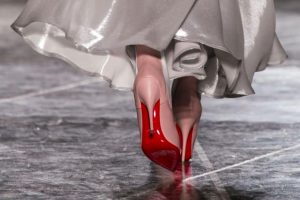Fashion Intellectual Property Law

Photo: Tristan Fewings/Getty Images
Susan Scafidi of the Fashion Law Institute breaks down the basics of Fashion Intellectual Property: Copyright and patent are all about incentivizing innovation and protecting new things, whereas trademark is about signs and symbols that indicate a company. Each of these things has very special implications in fashion–read on to find out how!
COPYRIGHT
One hundred years ago, the U.S. Copyright Office made a decision that all fashion is functional — all clothing, no matter how couture or elaborate. What can never be copyrighted is anything that is functional, or has a physical function in the real world, so therefore all clothing can never be copyrighted as it was already decreed purely functional…..HOWEVER: Fabric prints and jewelry are considered artistic/sculptural and not functional, and so are considered copyrightable, as copyright is generally associated with original visual works of art.
PATENT
Copyright just has to be original to the author; whereas patent has to be something that is not only useful, but new or novel such as an invention. There aren’t that many examples of this in fashion, however functional items like clasps, or Velcro, or high performance fabrics like Kevlar have been patented. The thing about patents is that they cost a lot of money and a patent attorney, whereas copyright protection is automatic, even if you don’t file for a copyright beforehand. However, ornamental aspect of the functional items can be patented, and these are called Design Patents. This very niche category protects the ornamental or decorative aspect of a functional item, such as a clever handle on a bag or a unique sculptural look to a shoe heel.
TRADEMARK
Trademark can’t protect an entire garment or clothing line, but it can protect the logo or brand label (think of Nike’s swoosh, the penguin, or the crocodile). Trademarks are not as cheap as copyright, and not as expensive as a patent. A somewhat confusing area of this is Trade Dress Protection, which means that when an element of the design actually serves as a logo. Christian Louboutin, for example, argued that his famous red heeled shoes where essentially the same thing as a logo, and therefore no one else had a right to that, otherwise consumers might see some other red heeled shoe of inferior quality and immediately think they were Christian Louboutins.
So, if you are a small brand or emerging designer, do you need to worry about all this? The bottom line is really, well, not really–unless you have the funds to invest in this upfront. Most emerging brands are most concerned with their designs being knocked off, and the US doesn’t have any laws that protect actual designs, because it would be very hard to legislate and enforce. And if a big brand does go after an indie designer’s looks, they are very careful to not copy anything in the copyright/patent/trademark-able domain (such as fabric prints, textile innovations, or logos) but basic designs are still up for grabs. Also, you do have some trademark protection even if you don’t register your logo for trademark–It’s called common-law trademark protection, but you may still choose to register the mark regardless if you feel it makes sense to do so. However, it might be more advisable to focus on building your brand first before worrying about it being copied—and to keep in mind that it is a time-honored tradition in fashion to re-use , recycle, or refurbish existing design concepts and styles, and that by entering into this industry we become participants, whether willingly or not, of this inevitable life cycle.